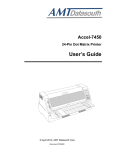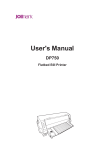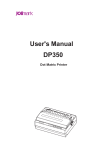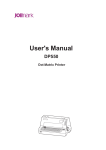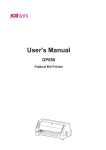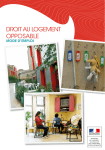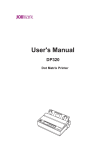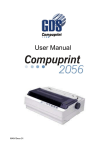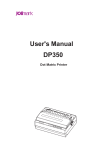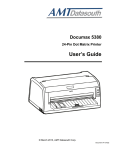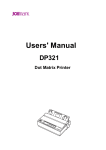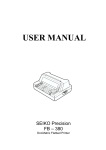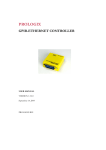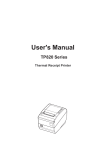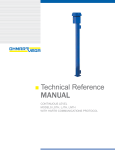Download BP-1000K (Model B) User`s Manual (V2.0)
Transcript
User's Manual BP-1000K (Model B) BP-1000K User’s Manual Declare About Trademark Corporation names and product names are the registered trademarks or commodity names of the corporation. * EPSON is a registered trademark of Seiko Epson Corporation. * ESC/PK2 is a registered trademark of Seiko Epson Corporation. * OKI is a registered trademark of Oki Data Corporation. * OKI 5530SC is a registered trademark of Oki Data Corporation. * IBM is a registered trademark of International Business Machines Corporation. * IBM 2391 is a registered trademark of International Business Machines Corporation. * Windows is a registered trademark of Microsoft Corporation. * OLIVETTI is a registered trademark of Olivetti Corporation. * OLIVETTI PR2 is a registered trademark of Olivetti Corporation. -i- BP-1000K User’s Manual Important Safety Instructions Read all of these instructions carefully and thoroughly and save them for later reference. The unauthorized operation would lead to malfunction or accident. Manufacturers have no responsibilities for the problems which are led by misoperations. 1. Follow all warnings and instructions in the manual as well as marked on the product. 2. Do not touch the print head if the printer has just been recently used as the print head may be hot. 3. Do not put your fingers under the left and right tractor sprocket covers of the tractor (optional) when installing the tractor paper. 4. Unplug this product from the power outlet before cleaning. Do not use liquid or aerosol cleaners. Use a damp cloth for cleaning. 5. Do not use this product near water. 6. Do not place this product on an unstable cart, stand or table. The product may fall, causing serious damage to you or the product. 7. Slots and openings on the cabinet and the back or bottom are provided for air ventilation. To ensure reliable operation of the product and to protect it from overheating, do not block or cover these openings. The openings should never be blocked by placing the product on a bed, sofa, rug or other similar surface. This product should never be placed near or over a radiator or heater. This product should not be placed in a built-in installation or kiosk stand unless proper ventilation is provided. 8. This product should never be placed near or over a radiator or heat origin, and should avoid of direct sunshine. 9. Do not locate this product where the cord would be walked on. When the cord or the plug is mangled, please stop using and get a new one replaced. Make sure the old one is far away from the printer, so it can avoid someone who does not know the inside story getting damage. 10. Do not use in locations subject to high humidity or dust levels. Excessive humidity and dust may cause equipment damage or fire. 11. Never push objects of any kind into this product though cabinet slots as they may touch dangerous voltage dots or short out parts. 12. Don’t remove the printer’s out-cover and repair the printer. When needed, call or take it to the professional. 13. To ensure safety, please unplug this product prior to leaving it unused for an extended period. The wall outlet you plan to connect to should be nearby and unobstructed. 14. Unplug this product from the power outlet and leave servicing to qualified service personnel under the following conditions: A. When the power cord or plug is damaged or frayed. B. If liquid has been spilled into the product. C. If the product has been exposed to rain or water. D. If the product does not operate normally when the operating instructions are followed. E. If the product has been dropped or the cabinet has been damaged. F. If the product exhibits a distinct change in performance, it indicates a need for service. Note: The contents of this manual are subject to change without notice. * All parts of the printer can be recycled. When it is abandoned, we can call it back freely. Please contact us when you abandon it. - ii - BP-1000K User’s Manual Table of Contents Declare..........................................................................................................................................................i Important Safety Instructions ....................................................................................................................ii Chapter 1 Product Features.......................................................................................................................1 Chapter 2 Checking and Installing ............................................................................................................3 2.1 Unpacking and Checking ....................................................................................................................3 2.2 Unpacking the Protective Materials.....................................................................................................3 2.3 Main Parts of the Printer......................................................................................................................4 2.4 Installing the Printer ............................................................................................................................4 2.4.1 Choose Proper Installing Place ....................................................................................................4 2.4.2 Installing the Paper Feed Knob ....................................................................................................4 2.4.3 Installing the Ribbon Cartridge .....................................................................................................5 2.5 Connecting to Your Computer .............................................................................................................7 2.5.1 Connecting the Parallel Interface..................................................................................................7 2.5.2 Connecting the USB Interface ......................................................................................................8 2.5.3 Connecting the Serial Interface Cable ..........................................................................................8 2.5.4 Connecting the Ethernet Interface Cable......................................................................................9 2.6 Connect the Power Core .....................................................................................................................9 2.7 Installing the Driver .............................................................................................................................9 2.8 Network Settings ............................................................................................................................... 12 2.8.1 Connecting Printer...................................................................................................................... 12 2.8.2 Setting IP Address ...................................................................................................................... 12 2.8.3 Installing Printer Network Driver ................................................................................................. 14 Chapter 3 Paper Process ......................................................................................................................... 22 3.1 Paper Switch .....................................................................................................................................22 3.2 Loading the Cut Sheet ...................................................................................................................... 22 3.3 Loading the Passbook....................................................................................................................... 23 3.4 Loading the Vertical Certificate.......................................................................................................... 23 3.5 Loading the Thick Paper ................................................................................................................... 24 3.6 Installing Tractor Paper ..................................................................................................................... 24 3.7 Tearing the Tractor Paper.................................................................................................................. 25 Chapter 4 Control Panel........................................................................................................................... 27 4.1 Key, Indicator Light and LCD Display on Control Panel ....................................................................27 4.2 Basic Operation of Control Panel ...................................................................................................... 27 4.3 The information on the LCD Display When at Stand by State ...........................................................28 4.4 Use of the Menu Setup System......................................................................................................... 29 4.4.1 Change the Current Setting of the Printer................................................................................... 29 4.4.2 Printing the Current Setting Report............................................................................................. 30 4.4.3 Menu Item Description................................................................................................................ 32 4.4.4 Online Aptitude Parameter Setting ............................................................................................. 33 4.4.5 Restoring Factory Printer Settings.............................................................................................. 34 4.4.6 Head Pin Test ............................................................................................................................. 34 4.5 TOF Adjustment ................................................................................................................................ 35 4.6 Tear Off Position Adjustment ............................................................................................................. 35 - iii - BP-1000K User’s Manual 4.7 The Self Test Functions..................................................................................................................... 35 4.7.1 ASCII Self-Test ........................................................................................................................... 35 4.7.2 Chinese Self Test Mode.............................................................................................................. 35 4.7.3 H Pattern Test............................................................................................................................. 36 4.7.4 Hex Mode ................................................................................................................................... 36 4.7.5 Dot Alignment Mode ................................................................................................................... 36 Chapter 5 Maintenance and Troubleshooting ........................................................................................ 38 5.1 Cleaning the Printer .......................................................................................................................... 38 5.2 Problems and Solutions .................................................................................................................... 38 5.3 Error Indication on the Display of Control Panel................................................................................ 40 Chapter 6 Paper Specification ................................................................................................................. 42 6.1 Cut Sheet Printable Area................................................................................................................... 42 6.2 Tractor Paper Printable Area ............................................................................................................. 43 6.3 Passbook Printable Area ................................................................................................................... 44 6.3.1 Size Specifications of Horizontal Passbook................................................................................ 44 6.3.2 Size Specifications of Vertical Certificate.................................................................................... 45 Appendix A Technical Specification........................................................................................................ 46 A.1 Technical Specification...................................................................................................................... 46 A.2 Parallel Interface............................................................................................................................... 48 A.3 USB Interface ................................................................................................................................... 49 A.4 Serial Interface.................................................................................................................................. 49 A.5 Ethernet Interface ............................................................................................................................. 51 A.6 Cautions of Printing .......................................................................................................................... 51 - iv - BP-1000K User’s Manual Chapter 1 Product Features Thank you for choosing Jolimark passbook printer. The printer is a product of 24 pin high quality 110 column multifunction passbook/certificate/report printer, it can fulfill your printing requirement. The printer has the specialties as follows: z Auto fit paper thickness function Use floating flat platen, have the function of Auto fit paper thickness which makes the printing quality better. Its maximum thickness can reach 3mm. z Have the function of auto Load/Eject and auto skew adjustment Cut sheet can feeding the paper in the front of the printer and auto load to the printing position. Also it has the function of Auto Skew Adjustment. If the paper is in less than 30 ° skews, it will auto adjust. The tractor paper is installed on the tractor (optional). You can control it by pressing button Load/Eject or LF/FF, so that the paper can auto feeding to the printing position. After printing, the paper would eject from the front of printer which make it easy to tear. z Auto detecting paper margin function It can base on the position of the paper to adjust the printing position, which avoids it printing out of the paper. z Any position to feed paper and printing function Adopt professional design of auto fit paper insert. The printer can fulfill any position to feed paper and printing function in the printable area. z One button to control the switch in paper modes You only need to press"the paper switchover" button which make it switch in 4 paper modes. It is more intelligence, convenience and simple. z Paper tear function This function can make the tractor paper auto feed to the paper tear position, so that it can tear paper accurately after printing. z Function of paper eject With this function the user can easy operate it by the control panel to eject the cut sheet and tractor paper from the printer. z Flat push paper feed mechanism which solve the problem of paper jam Innovative flat push paper feed mechanism which can make paper not skew and deforming, so that when it printing some special files (such as passbook, certificate, 1+n invoice, envelope, post card and labels) will not jam paper. z Control panel with high definition LCD display You can know the current printing state of the printer through the LCD display, and you can also finish all the function setting through the LCD display. z Holistic engineering design by the printer combine the user With the design of making the power switch, the operation button and the LCD display in the front of the printer. The knob is designed to at the right side of the printer, which make sure the user feel much comfortable and convenience. -1- BP-1000K User’s Manual z Safety design of humanization The printer installing a sensor of cover open which make the printer stop printing whenever the upper cover does not be covered and make the print head move to the middle position. If you close the cover it will continue printing again. z Function of auto select the data transmission interface The printer fittings the parallel interface, USB interface, serial interface and Ethernet interface. (According to specific interface standard) So it can receive the date of parallel interface (Centronics) and USB interface. Once the computer send out the date, the printer can detecting the type of the data and auto switch to the right interface to receive it. z High speed and super high speed printing with high quality The printer can be print the high quality by 10 CPI at normal mode with the speed of 100CPS. At high speed mode, the printer can be printing with the gap of 10 CPI at the speed of 300CPS. At super high speed mode, the printer can be printing with the gap of 10CPI at the speed of 360CPS. z High resolution of image printing Max resolution of 360DPI (horizon) × 360DPI (perpendicularity) and the image is most definitely. z Compatibility The command compatible the OKI 5530SC, Epson ESC/PK2, Olivetti PR2 and IBM which are popular control command in the printer market. z Letter quality font There are Roman, Sans Serif, Courier, Prestige, Script, OCR-A&B etc. characters which can compare with other band of printer. z Bar code memorizer There are standard bar code types show as follow: EAN-13, EAN-8, Interleaved 2 of 5, Matrix 2 of 5, Industrial 2 of 5, Code 39, Code 128 B, Code 128 C, NW-7. z Electronic menu The printer can setting the parameter by itself and saving into the memorizer of the printer. z Enhance Chinese character set This printer contains GB18030 Chinese character set and also supports 4 bytes Chinese printing. z Contain Bank system used character set It supports bank system used character set print out. z Contain any position paper feed function It supports to feed paper in any position on the paper path. z Contain break pin compensation function User can set the printer to print using the pin which is in good condition to compensate the break pin. z Pin switch printing mode User can set pins to switch while printing form transverse line in order to improve print head life. -2- BP-1000K User’s Manual Chapter 2 Checking and Installing 2.1 Unpacking and Checking Check the following items in the package, if any of these items is missing, please contact your dealer. (1) Printer; (2) Ribbon cartridge (JMR115); (3) Paper feed knob; (4) Driver CD; (5) Power cord; (6) Facility user's guide (as Figure 2-1 show). Printer Ribbon cartridge (JMR115) Paper feed knob Driver CD Power cord (Including User’s Manual and Driver) Facility user's guide Figure 2-1 Items in the packing list 2.2 Unpacking the Protective Materials 1. Open the packing box, lift up the printer, open the upper cover of the printer, remove the protective materials of the upper printer frame. 2. Save all the original packing materials, so that it can use when transporting the printer (show as figure 2-2). Protective materials Protective materials Protective materials Protective materials Protective materials Figure 2-2 Unpacking protective materials -3- BP-1000K User’s Manual 2.3 Main Parts of the Printer Figure 2-3and Figure 2-4 mark the names of main parts. Upper cover Ribbon cartridge Upper frame lever Carriage shaft Print head Ribbon guide board LCD display Paper feed knob Power switch Control panel Figure 2-3 Main parts of the printer (Front view) Serial interface or Tractor (Optional) Ethernet interface Power supply inlet Parallel interface USB interface Printer rear cover Figure 2-4 Main parts of the printer (back view) Note: According to specific interface standards 2.4 Installing the Printer 2.4.1 Choose Proper Installing Place When choosing the installing place please consider following problems: 1. The laying place must be plane and fixing. 2. When printing tractor papers, the paper must be fed through the rear of the printer. So you should leave enough space for safety printing. If you put the tractor paper on the floor, the horizon minimum range between the printer and the paper should over 30mm. The printer should be place where backside of the printer is away the wall over 60cm, which avoid the paper break off from the tractor (optional). 3. Easy for operation, the table board should not be too high, it can be suitable about 60cm. 2.4.2 Installing the Paper Feed Knob 1. Insert the paper feed knob into the fixing hold on the right on the printer (Show as figure 2-5). -4- BP-1000K User’s Manual Paper feed knob Figure 2-5 Installing the Paper feed knob Note:The D shape placket of the knob should match the D shape shaft inside the printer cover. 2. Press the paper feed knob till it very close up the cover of the printer. 2.4.3 Installing the Ribbon Cartridge 1. Switch on the Power and open the upper cover of the printer. The print head will move to the middle position automatically. Print head Figure 2-6 Move the print head to the middle position 2. Untie the upper frame lever of both sides, pull the upper frame up, and switch off the power. Figure 2-7 Pull up the upper frame 3. Hold the edge of the paper guide slice of both sides, and turn over it downwards. -5- BP-1000K User’s Manual Figure 2-8 Turn over the guide of the carriage 4. Buckle the bottom and upper button of the ribbon frame in turn into the slot of the printer frame. Figure 2-9 Installing the ribbon cartridge 5. Fix the ribbon core into the ribbon path. Figure 2-10 Installing the ribbon core 6. Turn the ribbon knob in the direction of the arrow to remove any slack from the ribbon. Then close the ribbon guide board. -6- BP-1000K User’s Manual Figure 2-11 Tighten up the ribbon core 7. Press down the upper frame and pull the upper frame lever to the front, lock the upper frame lever by pulling it backwards after the upper frame is in correct position. At last, close the upper cover. Figure 2-12 Lock the upper frame Note: 1. When you remove the ribbon cartridge, please refer to the description on the right and follow the steps. 2. When the print out becomes faint, you need to replace the ribbon cartridge. Use of worn out ribbon will damage the print head. 3. Never move the print head when the printer is ON condition or else the printer may be damaged. Don’t touch the print head as it will be hot during printing. 4. Use genuine Jolimark JMR115 consumables or else warranty will be void. 2.5 Connecting to Your Computer The printer can configured with a parallel interface, USB interface, serial interface and Ethernet interface. (According to specific interface standards) Connect your computer to the desired interface as your requirement. (Show as picture 2-13, 2-13, 2-14 and 2-15) Note: Before connecting the parallel interface, please make sure the power of the printer is shut down. Must after tighten the cable you may turn on the power, or it will damage the printer. 2.5.1 Connecting the Parallel Interface 1. Turn off both the computer and the printer. Plug the parallel cable connector securely into the printer’s parallel interface. Squeeze the wire clips together until they lock in place on either side of the connector. 2. Plug the other end of the cable into the computer’s parallel interface; then tighten the screws on either side of the connector. -7- BP-1000K User’s Manual Wire clips Parallel interface Parallel cable Figure 2-13 Connecting the parallel interface 2.5.2 Connecting the USB Interface 1. Plug the USB cable A end (flat shape) into the computer's USB interface. 2. Plug the USB cable B end (square shape) into the printer's USB interface. Caution: Don’t impact the plug after connecting to the USB interface. USB Interface USB cable Figure 2-14 Connecting the USB interface 2.5.3 Connecting the Serial Interface Cable 1. Turn off both the computer and the printer. Plug the serial interface cable connector securely into the printer’s serial interface. Then tighten the screws on either side of the connector. 2. Plug the other end of the cable into the computer’s serial interface; then tighten the screws on either side of the connector. Screw Serial interface Serial cable Figure 2-15 Connecting the serial interface cable -8- BP-1000K User’s Manual 2.5.4 Connecting the Ethernet Interface Cable Plug the crystal end of the Ethernet interface cable (RJ-45) into the printer's Ethernet interface, and then plug the other end into the LAN’s entrance as shown in Figure 2-16. Ethernet interface Ethernet cable Figure 2-16 Connecting the Ethernet interface cable Note: Please refer to the user’s manual for the detailed instructions of internet settings. 2.6 Connect the Power Core 1. Make sure the power switch on the printer is turned off. 2. Make sure the voltage required by the printer matches that of your electrical outlet. 3. If the power cord is not attached to the printer, connect it to the power supply inlet on the printer. 4. Plug the power cord into a properly grounded electrical outlet. (show as figure 2-17) Power supply inlet Electrical outlet Power cord Figure 2-17 Connecting the power cord to the printer Note:1. If the rated voltage and your outlet voltage do not match, contact your dealer for assistance. Do not plug in the power cord. 2. You should use the properly grounded electrical outlet 2.7 Installing the Driver Please use the cable to connect computer with printer, then turn on the computer and the printer, put the driver CD into the CD-ROM. Install driver by the following ways: Auto-installing way Double click the file “Setup.exe” in the driver disc, install driver by the following direct. Note: Auto-installing way needs the operating system of Windows 2000 or above. -9- BP-1000K User’s Manual Hand operated installing way Note: The hand-operated installing ways of serial interface and parallel interface are the same. 1) The installing steps of parallel interface for Windows 2000/XP/Vista are as follows: 1 Click “Start” → “Settings” → “Select Printers”. 2. Click “Add Printer”, then it pops up a window of “Add Printer Wizard”, click “Next”, then please read the select guide carefully, such as, select “Local printer” in the “Local or Network Printer” window, then click “next”. 3. A window of “Select a Printer Port” pops up, select a usable port. Such as, select “LPT1: (Recommended Printer Port)”, click “Next”. 4. A window of “Install Printer Software" pops up, click “Have Disk...”, click “Next”. 5. A window of “Install From Disk” pops up. Please according to the operating system environment, you should select the path as follow: CD-ROM → “Driver” → “WIN2000 (XP-Vista-Win7)”, click “Open”, then click “OK” to return to the window of “Install Printer Software”, select the respective model, click “Next”. 6. Follow the guide click “Next” gradually till the installation is finished. 2) The installing steps of parallel interface for Windows 7 are as follows: 1. Click “Start” → “Device and Printers”. 2. Click “Add Printer”, then it pops up a window of “Add Printer Wizard”, click “Next”, then please read the select guide carefully, such as, select “Local printer” in the “Local or Network Printer” window, then click “next”. 3. A window of “Select a Printer Port” pops up, select a usable port. Such as, select “LPT1: (Recommended Printer Port)”, click “Next”. 4. A window of “Install Printer Software” pops up, click “Have Disk...”, click “Next”. 5. A window of “Install From Disk” pops up. Please according to the operating system environment, such as Windows XP operating system, you should select the path as follow: CD-ROM → “Driver” →“WIN2000 (XP-Vista-Win7)”, click “Open”, then click “OK” to return to the window of “Install Printer Software”, select the respective model, click “Next”. 6. Follow the guide click “Next” gradually till the installation is finished. The USB interface installing steps for Windows 2000/XP/Vista/Win7 are as follows: The following steps are used Windows XP as example. There are slight differences among different operating systems. 1. Connect the printer to computer with an USB cable and turn on the printer. 2. After the computer find out new hardware and finish searching, pop up a window of “Found New Hardware Wizard”, choose “Install from a list or specific location (Advanced)”, click “Next”. 3. A window of “Found New Hardware Wizard” — “Please choose your search and installation options” pops up, choose “Don't search, I will choose the driver to install”, click “Next”. 4. A window of “Add Printer Wizard” pops up, click “Have Disk...”, click “Browse”. 5. A window of “Install From Disk” pops up. Please according to the operating system environment, you should select the path as follow: CD-ROM → “Driver” → “WIN2000 (XP-Vista-Win7)”, click “Open”, then click “OK” to return to the window of “Add Printer Wizard", select the respective model, click “Next”. 6. Follow the guide click “Next” gradually till the installation is finished. The installing steps for Windows 98 are as follows: (1) The installing steps with a parallel cable or a serial cable: 1. Click “Start” → “Settings” → “Printers”. - 10 - BP-1000K User’s Manual 2. Click “Add Printer”, then a window of “Add Printer Wizard” pops up, click “Next”, then please read the select guide carefully, such as, select “Local printer” in the “Local or Network Printer” window, then click “Next”. 3. A window of “Click the manufacturer and model of your printer” pops up, click “Have Disk...”, please click “Browse”, select the path as follow: CD-ROM → “Driver” → “WIN98 (WINME)”, then click “OK”. 4. A window of “Install From Disk” pops up, click "OK, return to a window of “Add Printer”, select the respective model, and then click "Next". 5. A window of “Printer port” pops up, select “Available ports”, such as, select “LPT1: Printer Port”, click “Next”, and then show the printer’s name. If the system is not installed by other printer driver process, the printer is treated as default printer by the application process of Window98 environment, click “Next”. Otherwise according to prompt, choose the printer is default: “Yes”, click “Next”, choose “Yes-(recommended)”, click “Finish”. A window of “Printer test page completed” pops up, click “Yes”. 6. The printer driver process is installed successfully. (2) The installing steps with an USB cable: Note: 1. As the system of Windows 98/ME doesn’t have integrated USB driver control, please install USB driver before using USB interface printing. Then install USB printer driver. 2. If it has installed the USB driver, please install the USB printer driver directly as the following steps. USB driver installing steps: 1. Connect an USB cable and turn on the printer. 2. After the computer find out new hardware and finish searching, a window of “Add New Hardware Wizard” pops up, click “Next”. 3. A window of “Add New Hardware Wizard” — “Windows operation” pops up, choose “Search the best driver for the device (recommended)”, and click “Next”. 4. A window of “Search for new drivers” pops up, check “Specify a location”, click “Browse”, select the path as follows: CD → ROM → “Driver”-“[WIN98 (WINME) \ USBdriver]”, then click “OK”. 5. Return to a window of “Search for new drivers”, click “Next”; a window of “Windows driver file search for the device” pops up, click “Next”. 6. After the system finishing installing the file automatically, a window of “USB Print Supported” pops up, click "Finish". 7. The printer USB driver process is installed successfully. USB printer driver installing steps: 1. Click “Start” → “Settings” → “Printers”. 2. Click “Add Printer”, then a window of “Add Printer Wizard” pops up, click “Next”. 3. A window of “Click the manufacturer and model of your printer” pops up, click “Have Disk...”, please click “Browse”, select the path as follow: CD-ROM → “Driver” → “WIN98 (WINME)”, and then click “OK”. 4. A window of “Install From Disk” pops up, click “OK”, return to a window of “Add Printer”, then click "Next". 5. A window of “Printer port” pops up, select “Available ports”, select “JMUSB”, click "Next", and then show the printer’s name. If the system is not installed by other printer driver process, the printer is treated as default printer by the application process of Window98 environment, click “Next”. Otherwise according to prompt, choose the printer is default: "Yes", click "Next" choose “Yes-(recommended)”, click “Finish”. A window of “Printer test page completed” pops up, click “Yes”. 6. The printer driver process is installed successfully. - 11 - BP-1000K User’s Manual 2.8 Network Settings Please use Jolimark network setting software NetFinder to set the IP address for Jolimark printers, which can be found in the CD or downloaded from www.jolimark.com. Note: The network printing function needs the operation system of Windows2000 or above. 2.8.1 Connecting Printer Power on the printer, connect with the Ethernet cable which has been connected to LAN, and look into the information of Ethernet LED indicator to ensure the printer has entered into the normal connection. Yellow LED Green LED Description ON Blink Connecting to network OFF OFF Not connecting to network 2.8.2 Setting IP Address 1. Run NetFinder Software Double click NetFinder.exe in the PC which connects the printer in the same LAN. The figure of the software is shown as follows: Button description: Exit — Exit from the software Search — Search printers in the same LAN Assign IP — Modify the IP address and other settings for the specified printer. 2. Search printer Click "Search" button in the main interface, the dialog box appearing would begin searching automatically and show appearance, listing a printer in the main interface if found. The time is counting down in the progress bar (10s in total) and the search would finish as soon as the time is over. When going on searching, press “search” button again. - 12 - BP-1000K User’s Manual If the printer still can not be found out when the network connection is correct and in the same network, please check whether the network fire wall on the PC open or not. If there is fire wall, please close it temporarily, open again after finishing searching and setting a printer completely. 3. Setting printer’s IP address The printer’s information is listed in the main interface, the left side of which is the model and description and the right are the IP address and MAC address. What’s more, the assign mode (dynamic/static) is noted behind the IP address. 1) Correlative description for IP address settings In order to search and set printer’s IP address conveniently for the first time, the factory default setting is DHCP mode which assigns IP address dynamically. If there is no DHCP server in the connected LAN and printer is set to DHCP mode as well, then it would use the internal pre-set address (IP: 10.0.0.1, Subnet Mask: 255.255.255.0) automatically. - 13 - BP-1000K User’s Manual It is suggested that printer’s IP set to static in actual usage, which can cut down the time when initializing the Ethernet interface as the printer is turned on and prevent IP conflicts (The dynamic address used in printer may conflict with another one). The network segment part of the IP address and Subnet Mask must be the same as those of PC connecting with a printer. For example, the address of working PC is 192.168.0.1/255.255.255.0 (IP/Subnet Mask),then which of printer should be set to 192.168.0.x/255.255.255.0(x=2~254 and should avoid the IP in used. It is not restricted for NetFinder to search printers in the same network but different segment parts (can not stride gateway). Relative glossary of IP address may refer to corresponding information. 2) Setting printer’s IP address Select the printer information to be modified (black frame appears), click "Assign IP" button. Set the IP in the dialog box appearing. Check the “Use DHCP” if need to assign dynamic address, the settings above would be disabled automatically. Please make sure there is a DHCP server in the network, or the printer can not receive an effective IP address. When to specify static address, uncheck “Use DHCP” and fill in “IP address”, “Subnet Mask” and “Default Gateway”. If there is no gateway in the network, fill 255.255.255.255 in the “Default gateway”. “IP address” and “Subnet Mask” should obey the assigning rules of local LAN (Ethernet), please enquire the administrator of networks which the printer connects to for more details. Click “OK” to send address setting information to the specified printer. The printer takes response after “Close this window on success” is checked, and then this dialog is closed automatically. Select “Reload Timer” then the software would wait for the printer’s response. Generally, printer would take response in a circle time if network connection is correct. Click “Cancel” if you abandon the modification. Click “Search” in the main interface again to update printer information after modifying the printer’s IP address. 3) Report printer’s IP address Report the printer’s IP address, which would be used in the section “Newly-install printer network driver” or “Upgrade-install printer network driver (setting driver’s network port)”. 2.8.3 Installing Printer Network Driver The ways of installing network driver are classified into Newly-install way and Upgrade-install way - 14 - BP-1000K User’s Manual according to whether the PC installs the printer driver or not. If the printer driver hasn’t been installed on the PC, adopt newly-install way whose steps are shown in “Newly-install printer network driver”. If the printer driver has been installed on the PC, adopt Upgrade-install way whose steps are shown in “Upgrade-install printer network driver”. 1. Newly-install printer network driver 1) Click “Start” → “Settings” → Select “Printers”. 2) Click “Add printer”, then a window of “Add Printer Wizard” pops up, click “next”, then please read the select guide carefully. Such as, select “Local or Network Printer”, then click “next”. 3) A window of “Select the Printer port” pops up, select a port you want your printer to use. For example, select “Create a new port”, select “Standard TCP/IP Port” in the port, click “next”. 4) A window of “Add standard TCP/IP Printer Port Wizard”, click “Next”. 5) A window of “Add Port” pops up, enter the IP address reported by the “Setting printer’s IP address” in the “Printer Name or IP Address” column. Take IP address “192.168.0.240” for example. “Port Name” is created automatically after finishing filling in IP address. - 15 - BP-1000K User’s Manual 6) A window of “Additional Port Information Required” pops up, select “Custom” in the “Device Type”, then click “Settings”. 7) A window of “Port Settings” pops up. Affirm that “Port name” and “Printer name or IP address” are correct, “Protocol” is “RAW” and “Port Number” is “9100”, click “OK”. - 16 - BP-1000K User’s Manual 8) Return to “Additional Port Information Required”, click “Next”. 9) A window of “Completing the Add Standard TCP/IP Printer Port Wizard” pops up, click “Finish”. 10) In the selection of “Manufacturers/Printers”, click “Have Disk”, and then click “Next”. 11) A window of “Install From Disk” pops up. Please according to the operating system environment, such as Windows 2000/XP/Vista/Win7 operating system you should select the path as follows: CD-ROM → “Driver” → “WIN2000 (XP-Vista-Win7)”, click “open”, then click “OK”, then return to the window “install printer software”, select the respective model, click “next”. 12) Follow the direct click “next” gradually till the installation is finish. At this time, printer network driver is installed completely. 2. Upgrade-install printer network driver (setting driver’s network port) If PC has installed the printer’s driver, set driver’s network port to carry out network printing. The concrete steps are shown below: 1) Click “Start” → “Settings” → “Select Printers”. 2) Right click BP-1000K driver, click “Properties” on the window popping up. 3) A window of “Properties” pops up, click “Ports” and “Add Ports”. - 17 - BP-1000K User’s Manual 4) A window of “Printer port” pops up, select “Standard TCP/IP Port”, click “New port”. 5) A window of “Add Standard TCP/IP Printer Port Wizard” pops up, click “Next”. 6) A window of “Add a port” pops up, import the IP address reported by the “Setting printer’s IP address” in the “Printer name or IP address” column. Take IP address “192.168.0.240” for example. “Port name” is created automatically after finishing filling in IP address. Click “Next”. - 18 - BP-1000K User’s Manual 7) A window of “Additional Port Information Required” pops up, select “Custom” in the “Device Type”, then click “settings”. 8) A window of “Port Settings” pops up. Affirm that “Port name” and “Printer name or IP address” are correct, “Protocol” is “RAW” and “Port Number” is “9100”, click “OK”. - 19 - BP-1000K User’s Manual 9) Return to “Additional Port Information Required”, click “Next”. 10) A window of “Completing the Add Standard TCP/IP Printer Port Wizard” pops up, click “Finish”. 11) Return to “Printer Ports”, click “Close”. 12) Return to “Properties”, make sure the network port is selected, click “Apply”, and then click “Close”. Thus, printer’s network port setting is finished. - 20 - BP-1000K User’s Manual - 21 - BP-1000K User’s Manual Chapter 3 Paper Process 3.1 Paper Switch When this printer leaves factory it configures with four paper process modes, that are cut sheet mode, passbook mode, thick paper mode and continuous paper mode. 1) Cut sheet mode (Front feed): It is fit for the medium of A4 and thin paper. 2) Passbook mode (Front feed): It is fit for the medium of passbook and vertical certificate which thickness is less than 2mm. 3) Thick paper mode (Front feed): It is fit for the medium or the certificate which the thickness is over 2mm. 4) Continuous paper mode (Rear feed): It is fit for the tractor paper printing. You can base on the print medium as your actually need to choose the respective paper process mode (Cut sheet, passbook, thick paper or continuous paper). Please check the detail way of switching paper in Chapter 4 Control Panel. 3.2 Loading the Cut Sheet You can feed a piece of cut sheet and a single piece of multi-ply paper which maximum is 7 plies (1 original + 6 copies). Follow the steps as below to load cut sheet: 1. Turn on the printer and setting the paper process to cut sheet mode. 2. Place the cut sheet on the front platform and feeding the paper into the printer within the scale scope of which sign above the paper entrance of the printer. After the printer auto skew adjustment, the paper would be sent to the printing home position, and then it is ready to be printed. 3. When loading both single piece of the multi-ply notes and multi-ply tractor paper, you should read the reference below to set the copy mode. Figure 3-1 Loading cut sheet Table 3-1: Copy mode setting reference Paper thickness (mm) Copy mode setting on the control panel 1 or 2 0.06~0.12 Normal 3 or 4 0.18~0.24 1+ 3 copy mode 5 0.30 1+ 3 copy mode 6 0.36 1+6 copy mode 7 0.45 1+6 copy mode Copy paper (Including original pattern) Note:1. Please refer to Chapter 4 Control Panel for the setting method of copy mode. 2. Normal mode fits for the medium of thin papers, cut sheets, 1+1 ply notes and cards. - 22 - BP-1000K User’s Manual 3. 1+3 copy mode fits for the 1+2~4 ply paper, passbook, registered permanent residence book, driving license, various license, etc.. 4. 1+6 copy mode fits for 1+5 ply or 1+6 ply papers. 3.3 Loading the Passbook Follow the steps as below to load passbook: 1. Turn on the printer and setting the paper process to passbook mode. 2. Open the passbook, turn to the page which should be printed and make it flat. 3. Place the passbook on the front platform and feeding the passbook into the printer within the scale scope of which sign above the paper entrance of the printer. After the printer auto skew adjustment, the passbook would be sent to the printing home position, and then it is ready to be printed. Note:1. When printing on passbook which thickness is less than 2mm, you also could set the paper process to cut sheet mode, but the printing effect of passbook mode is better than that of cut sheet mode. 2. Don’t feed a passbook with creases or rip. 3. Close the upper cover before printing or it would not print. Figure 3-2 Loading the passbook 3.4 Loading the Vertical Certificate Follow the steps as below to feed vertical certificate: 1. Turn the printer on and setting the paper process to passbook mode. 2. Open the certificate, turn to the page which should be printed and make it flat. 3. Place the certificate on the front platform and feeding the certificate into the printer within the scale scope of which sign above the paper entrance of the printer. After the printer auto skew adjustment, the certificate would be sent to the printing home position, and then it is ready to be printed. Note: 1. Don’t feed a certificate with creases or rip. 2. Close the upper cover before printing or it would not print. 3. The thickness difference of right pages and left pages should not over 1.2mm. - 23 - BP-1000K User’s Manual Figure 3-3 Loading the vertical certificate 3.5 Loading the Thick Paper Follow the steps as below to feed the paper which the thickness is over 2MM: 1. Turn on the printer and setting the paper process to thick paper mode. 2. Open the certificate, turn to the page which should be printed and make it flat. 3. Place the certificate on the front platform and feeding the certificate into the printer within the scale scope of which sign above the paper entrance of the printer. After the printer auto skew adjustment, the certificate would be sent to the printing home position, and then it is ready to be printed. Note:1. Don’t feed the certificate with creases or rip. 2. Close the upper cover before printing or it would not print. Figure 3-4 Loading the thick certificate 3.6 Installing Tractor Paper 1. Remove the rear cover of the tractor on the rear of the printer. Sprocket cover Sprocket Right lock lever Tractor Cover Figure 3-5 Remove the tractor cover - 24 - BP-1000K User’s Manual 2. Connect the printer and turn on the power, and switch the paper process mode to continuous paper mode. (Please see the operation way in Chapter 4 Control Panel). 3. Loosen the sprocket lock levers of the tractor (optional), and then move the left sprocket to the fitting position, and press down the lock lever to lock the left sprocket. 4. Open the sprocket cover, then install the tractor paper onto the sprockets and close the sprocket cover. (As shown in figure3-6) Figure 3-6 Installing the tractor paper onto the sprocket of the tractor (optional) Remark Please remember to place the top of paper in level position (Show as figure 3-7). Tractor (optional) sprocket cover Top of the paper Figure 3-7 Installing the tractor paper on the tractor (optional) sprocket 5. Adjust the position of right sprocket to fit the paper width, and then lock it. 6. If the paper is crinkle, please adjust the right lock lever to the suited position. (Show as figure 3-5) 7. Adjust the paper to the printable position. Please check if the tractor paper fit for the printer printing requirement. If the paper is crinkle, please adjust the right sprocket to the suited position. 8. Refer to table 3-1, according to the paper ply to select the proper copy mode which would make the printing more legible. 3.7 Tearing the Tractor Paper In the default setting of the printer, the function of feeding paper to tear off position has been opened. After printing, the printer will feed the tractor paper to tear off position automatically. You can tear the paper along the edge of the printer cover. (Show as figure 3-8) If you have changed the default setting and have closed the auto-feed paper to tear off function, press the key of Load/Eject after printing, the printer will feed the tractor paper to tear off position. Before tearing the tractor paper, if the paper perforation does not reach the edge of the cover, please adjust the tearing position. (Refer to Chapter 4 Control Panel) - 25 - BP-1000K User’s Manual Figure 3-8 Tearing the tractor paper - 26 - BP-1000K User’s Manual Chapter 4 Control Panel 4.1 Key, Indicator Light and LCD Display on Control Panel There are five keys, two LED indicator lights and a LCD display on control panel. (Show as figure 4-1) The LCD display is a dot matrix display module (106×56dots), and the display dimension is 32.6mm×17.6mm. The control panel is shown as the following figure: Figure 4-1 Control panel ◆ The meaning of indicator show as follow table: Table 3-1: The meaning of indicator light on the control panel Indicator light Power (Red) Online (Green) Off On Blink Power off Power on Paper out or malfunctions occurs Offline Online —— 4.2 Basic Operation of Control Panel There are five operation keys on the control panel. ►II Online Press Online key, switch between Online mode and Offline mode. ▼Load/Eject When the printer is offline, in cut sheet mode, press this key can eject cut sheet. In tractor paper mode, press this key when offline can switch the tractor paper among ready position, printing home position and tear off position. (Tractor is optional) When the printer is online, hold on pressing this key for about 3 seconds, the printer will enter Menu setup mode. ▲ LF/FF In the offline mode, press the LF/FF key to feed the paper line by line. Alternatively, hold the LF/FF key down, the printer will eject the cut sheet, or feed the tractor paper one page. - 27 - BP-1000K User’s Manual ◄ High Speed In the offline mode, press High Speed key can switch the speed mode of “Normal Speed”, “High Speed” or “Super High Speed”. At the same time, the LCD display will show you the current printing speed. In the online mode, press the key about 2 seconds, the printer switch among four paper modes of “cut sheet”, “passbook”, “thick paper” or “continuous paper”. At the same time, the LCD display will show you the current paper mode. ► Copy In the offline mode, press Copy key can switch among three copy modes of “Normal”, “1+3 copy” or “1+6 copy”. At the same time, the LCD display will show you the current copy mode. 4.3 The information on the LCD Display When at Stand by State In the state of stand by (not error state), the printer BP-1000K would display some common state information of the printer on the LCD. The information would towards left cycle roll display as follow format: Paper information+speed information+copy information+[Self test printing information] Paper information: 1) Cut sheets Speed information: 1) Normal Copy information: 1) Normal 2) Passbook 2) High Speed 2) 1+3 copy 3) Thick paper 4) Continuous paper 3) Super high speed 3) 1+6 Copy Self test printing information: 1) Chinese self test test 2) English self test 3) H printing test 4) Aging Hereinto, the paper information would display with an icon, show as follow. While the arrow on the icon is show the way of paper feeding. 1) Cut sheets, show as follow: Paper: Cut sheets _ _ _ 2) Passbook, shown as follow: Paper: Passbook _ _ _ Note: In this paper mode, LCD display information in not cycle roll. 3) Thick paper, show as follow: Paper: Thick paper _ _ _ - 28 - BP-1000K User’s Manual 4) Continuous paper, show as follow: Paper: Continuous paper _ _ _ 4.4 Use of the Menu Setup System 4.4.1 Change the Current Setting of the Printer The menu of BP-1000K is containing main menu and sub menu, and displays it on the LCD display. Users can easy setting all the basic functions of the printer. In online mode, press the “Load/Eject” key for 3 seconds, the printer enters into the menu setup mode. Press “▲” and “▼” keys, you can select the options in same menu. Hold and press down “▲” and “▼” keys to select quickly. Press “◄” key, you can go back to main menu or exit the menu setup mode. If current menu is in main menu then would exit the menu setup mode and make the options you just changed take effect at the same time Press “►” key to entre the sub menu. Press “►II” key to save the setting, and it would mark a “√” on the current selected parameters. Detailed instruction is shown as follow: 1) After entering the menu setup mode, the LCD display initial data is shown as the following figure: Menu setting 1. PRT-SPEED 2. Copy ► ► 2) Press“▲”, “▼” keys to choose the menu items (as the following figure shown). Menu setting 2. Copy ► 3. Emulation ► There are 35 options in the main menu of BP-1000K: 1.PRT-SPEED; 2.COPY; 3.EMULATION; 4.CHAR MODE; 5.FONT; 6.COMPRESS; 7. AUTO-COMP; 8.PITCH; 9.CHIN.PITCH; 10.LINE SPACE; 11.FORM; 12.PAGE SKIP; 13. TEXT DIR; 14.GRAPH DIR; 15.LEFT EDGE; 16.SLASH ZERO; 17.CHAR SET; 18.INTL CHAR; 19. CODE PAGE; 20.LANGUAGE; 21.QUIET MODE; 22.AUTO LF; 23.AUTO CR; 24.TEAR OFF; 25.LOAD PAPER; 26.SKEW; 27.COVER OPEN; 28.EJECT; 29.BAUD RATE; 30.PARITY; 31.DATA BIT; 32.STOP BIT; 33.PROTOCOL; 34.BREAK PIN; 35. PIN SWITCH 3) Press “►” key to enter the sub menu For example, after choose “PRT-SPEED”, press “►” key to enter the detailed options about printing speed (as the following figure shown). - 29 - BP-1000K User’s Manual Menu setting 1. PRT-SPEED ► 2. Copy ► PRT-SPEED ► 1. NORMAL ► 2. High Speed √ As the right picture shows, the option which marks with a “√” is the current default setting. 4) Press “▲”,“▼” keys for up and down selection. For example, if you need to change the speed to “super high speed”, you can press “▲” or “▼” key to choose that, then press “►II” key to save your selection. New selection would mark with a “√” after saving. (As the following figure shown) PRT-SPEED 2. High Speed √ ►II PRT-SPEED 2. High Speed 3. Super High Speed √ 3. Super High Speed 5) Press “◄” key to go back to main menu, then press “◄” key again to exit the menu setup mode and the new setting will take effect at the same time. (As the following figure shown) Menu setting PRT-SPEED 2. High Speed 3. Super High Speed √ ◄ 1. PRT-SPEED ► 2. COPY ► ◄ Paper: Cut sheet _ _ _ 4.4.2 Printing the Current Setting Report If you need to know current setting, you can print the current setting report by the following steps: 1. Turn off the printer. 2. If use tractor paper, you should install the paper on the tractor (optional) properly. 3. Hold and press down both Load/Eject and LF/FF keys while turning on the printer, the printer will print out the current setting report. (Shown as figure 4-2) - 30 - BP-1000K User’s Manual Jolimark BP-1000K Current Setting Report Version: 1000K vx.x xxx/xx/xx PRINT SETUP PRT-SPEED COPY EMULATION CHAR MODE FONT COMPRESS AUTO_COMP PITCH CHIN. PITCH LINE SPACE FORM NORMAL NORMAL EPSON ASCII ROMAN 100% OFF 10 CPI 6.7 CP 6 LPI PAGE SKIP TEXT DIR GRAPH DIR LEFT EDGE OFF BI-DIR BI-DIR 0/10 INCH A4 CHARACTER SLASH ZERO CHAR SET INTL CHAR U.S.A. CODE PAGE U.S.A. SYSTEM SETUP LANGUAGE QUIET MODE AUTO LF AUTO CR TEAR OFF LOAD PAPER SKEW COVER OPEN EJECT SERIAL I/F BAUD RATE PARITY DATA BIT STOP BIT PROTOCOL BREAK PIN HEAD PIN PIN SWITCH OFF GRAPHICS ENGLISH OFF OFF ON 0.5 SEC 0.1 SEC ON ON FRONT 9600 BPS NONE 8 BIT 1 BIT DTR LIVE OFF Figure 4-2 Printing current setting report - 31 - BP-1000K User’s Manual Note: If the printer doesn’t install Ethernet interface, the Ethernet interface information of MAC or IP would not be printed out in self-test mode and current setting report. 4.4.3 Menu Item Description Table 4-2: Menu item descriptions are as follow: Item Description PRT-SPEED Specify the print speed of printer. higher. COPY According to customer's printing requirement, select the printing capability. EMULATION Specify printer's control commands. CHAR MODE Select ASCII or Chinese character mode to print when printer receives character printing task. FONT Specify a kind of ASCII fonts to print when printer receives character printing task. If the print data with font instruction, printer gives priority to print data instruction. (Only valid when CHARACTER MODE is choosing ASCII) COMPRESS Transverse compress printing is according to corresponding compress proportion. AUTO-COMP After selecting this function on, printer would print out transverse compressed content according to the specified percentage in normal speed. When auto-compress mode is selected, printer would detect paper width automatically and choose the proper percentage to print. PITCH Specify the ASCII character spacing in characters per inch (cpi). CHIN. PITCH Specify the Chinese character spacing in characters per inch (cpi). LINE SPACE Specify the line spacing in lines per inch(lpi). If the print data with vertical pitch instruction, printer would give priority to print data instruction. FORM Specify the page length of the form, for both cut sheet and continuous paper. Printer feeds to next page according to the specified page length. If the print data with page length instruction, printer would give priority to print data instruction. PAGE SKIP After selecting this function on, printer would leave one inch (25.4mm) margin at the perforation of the tractor paper automatically. If the print data with page margin instruction, printer would give priority to print data instruction. TEXT DIR Set unidirectional or bidirectional printing for text. Bidirectional (the default) is faster because the printer prints in both directions. Unidirectional is slower but produces better printing quality. GRAPH DIR Set unidirectional or bi-directional printing for graphics. It is set to UNI-DIR by default for better quality. (only compatible with EPSON) LEFT EDGE Specify the distance between paper left edge and printing home position. (Only valid when ANY POSITION PAPER FEED function is on.) SLASH ZERO Select the printing character for zero with a slash(/) or without, to distinguish it from the letter O. CHAR SET Specify character set as Italic Character or Graphic Character. INTL CHAR Specify the printer internal character set according to different using circumstances of international characters. CODE PAGE Select the code page according to different national characters use circumstances. LANGUAGE Specify the printer menu language as English or Chinese. - 32 - Printing resolution is lower while print speed is BP-1000K User’s Manual QUIET MODE Disable or enable the low noise function, when this function is on, print speed would be reduced. AUTO LF If this function is on, printer would advance the paper one line automatically after receiving every carriage return instruction. AUTO CR After selecting this function on, printer would feed the paper one line after receiving every line feed instruction. Print head would move to the printing home position automatically. TEAR OFF After selecting this function on, when the printer has finished printing, paper would be fed to the set tear off position automatically, and you should tear off the paper manually. LOAD PAPER Specify the wait time between cut sheet is put into the paper guide and it is fed into the printer. Choose to wait specify time or press LF/FF key to feed paper. SKEW After selecting this function on, printer would adjust the skew paper automatically when loading cut sheet. (Only valid when tilt angle is within 30°.) COVER OPEN After selecting this function on, if the upper cover is open, printer would stop printing with an alarm. EJECT Specify paper eject direction when loading paper from front. BAUD RATE Specify the printer serial data transfer rate. PARITY Specify the parity bit for serial data transfer. DATA BIT Specify the serial data bits. STOP BIT Specify the serial data transfer stop bit. PROTOCOL Specify the protocol of printer serial data transfer as software control (XON/XOFF) or hardware control (DTR). BREAK PIN Select the broken pin. Printer would automatically replace it with other pin to print. PIN SWITCH After selecting this function on, printer would switch different pins to print table line automatically. 4.4.4 Online Aptitude Parameter Setting This printer supports online aptitude parameter setting, you can set the printer parameter in PC through the Driver of this printer. The concrete setting steps are shown as follows: 1. Ensure the printer and the computer are connecting with USB interface cable. Turn on both the printer and the computer, and the printer is in online mode. 2. Click “Start” → “Settings” → “Printers”. 3. Right click “Jolimark BP1000K” in the “Printers”, select “Properties”. 4. Click “Device Property” in the property page. - 33 - BP-1000K User’s Manual 5. The setting way is corresponding with that of printer menu system. In the “Printer Settings” layout, select the first class menu in the combobox of “Select Printer Setting Class”, select the second menu in the “Configuration” and set the item in the current parameters list. 6. Click the button “Reset All” to reset all the parameters to be the driver’s default, but not change the printer’s settings. 7. When setting the parameters: you can click “Set Item” to save the current settings after setting each item, or you can also click “Set All Items” after setting all parameters. After clicking “Set All Item” or “Set Item”, the parameter’s instruction would be sent to the printer. 8. The printer’s parameter settings are changed at once after receiving the instruction and the printer does not need to restart. 9. After finishing settings, click “OK”, exit the “Properties” window. 4.4.5 Restoring Factory Printer Settings You can restore to the factory printer settings without having to work through the Menu Setup System to reset the menus. To restore to the factory settings: 1. Make sure that the printer is Online. 2. Press and hold down the Online and Copy keys on the control panel for 3 seconds. The LEDs of the Power and Online on the control panel blink 3 times at the same time and the printer makes 2 beeps to confirm that the printer’s factory settings have been restored. 4.4.6 Head Pin Test Press down High speed key then turn on the printer. The printer would print out a piece of “Head pin test” pattern. 24 pins would print out respective 24 lines which are marked with number 1 to 24. If certain pin cannot print its line, select broken-pin number in Break Pin mode in the menu. - 34 - BP-1000K User’s Manual 4.5 TOF Adjustment TOF is mean top of form position. When paper is loaded, the printer detects the end of the paper and determines the printing start position based on the detected paper end. That position is the top of the form. When the printer online, press ▲ LF/FF key for 3 seconds, and the printer LEDs of the power and online on the control panel blink by turns. The LCD display as right figure shows. That is mean the printer is in the mode of TOF adjustment. Top of Form adjusting… (default) Press “▲”, “▼” keys can change the setting of TOF (the maximum dimension of the changing of TOF is measure by the default setting under zero position): Press “▲” key one time go forward 1/60 inch, maximum is 60/60 inch. Press “▼” key one time go backward 1/60 inch, maximum is 30/60 inch. After adjustment, press “►II” key, the power light and the online light blink 3 times at the same time, and make out 2 beeps. Now the setting of TOF has been saved and exit. 4.6 Tear Off Position Adjustment “Tear position adjustment” mainly use to adjust the distance between the perforations and the upper cover which make you more easily to tear the tractor paper. In the online mode, press ▲ Load/Eject and ▼ LF/FF keys at the same time for 3 seconds, then can enter the mode of tear off position adjustment. Here, the online light and the power light blink by turns, the LCD display as right picture shows. Tear-off pos. adjusting… (default) You can adjust the tear position by pressing “▲”and“▼” keys, (the maximum dimension of the changing of tear position is measure by the default setting under zero position): Press “▲” key one time go forward 1/60 inch, maximum is 15/60 inch. Press “▼” key one time go backward 1/60 inch, maximum is 15/60 inch. After adjustment, press “►II” key, the power light and the online light blink 3 times at the same time, and make out 2 beeps. Now the setting of tear position adjustment has been saved and exit. 4.7 The Self Test Functions 4.7.1 ASCII Self-Test Hold down Online key then turn on the printer. The printer would print out a piece of ASCII pattern and then exit ASCII self test mode. Now you can start printing. If you press Online key and Load /Eject key at the same time then turn on the printer, it will print out the ASCII pattern continuously. Press Online key to pause it. If you want to exit now, you can turn off the power then turn on again. ASCII SELF TEST MODE Version: BP-1000K v XXX 20XX/XX/XX !"#$%&’( )*+-./0123456789:;<=>?@ABCDEFGHIJKLMNOPQRSTUVWXYZ[\]^_`abc !"#$%&'( )*+-./0123456789:;<=>?@ABCDEFGHIJKLMNOPQRSTUVWXYZ[\]^_`abcd "#$%&'( )*+-./0123456789:;<=>?@ABCDEFGHIJKLMNOPQRSTUVWXYZ[\]^_`abcde Figure 4-3 ASCII self test mode 4.7.2 Chinese Self Test Mode Press down LF/FF key then turn on the printer. The printer would print out Chinese pattern. Press Online key to pause it. If you want to exit now, you can turn off the power then turn on again. - 35 - BP-1000K User’s Manual CHINESE TEST MODE Version: 1000K v XXX 20XX/XX/XX 、 『 ∫ £ ⅳ 」 ⊙ ¢ ⅲ 。 』 ∮ ‰ ⅴ · ˉ ˇ 〖 〗 【 ≡ ≌ ≈ § № ☆ ⅵ ⅶ ⅷ ¨ 】 ∽ ★ ⅸ 〃 々 ± × ∝ ≠ ○ ● ⅹ ⒈ — ÷ ≮ ◎ ⒉ ~ ‖ … ‘ : ∧ ∨ ∑ ≯ ≤ ≥ ∞ ◇ ◆ □ ■ ⒊ ⒋ ⒌ ⒍ ’ ∏ ∵ △ ⒎ Figure 4-4 Chinese self test mode 4.7.3 H Pattern Test Hold down Online key and LF/FF key then turn on the power, the printer would print out one page of H pattern then exit the self test mode. Now you can start printing. Hold down Online key, LF/FF key and Copy key at the same time then turn on the power, the printer would print H pattern continuously. Press Online key to pause it. If you want to exit now, you can turn off the power then turn on again. H SELF TEST MODE Version: BP-1000K v XXX 20XX/XX/XX HHHHHHHHHHHHHHHHHHHHHHHHHHHHHHHHHHHHHHHHHHHHHHHHHH HHHHHHHHHHHHHHHHHHHHHHHHHHHHHHHHHHHHHHHHHHHHHHHHHH HHHHHHHHHHHHHHHHHHHHHHHHHHHHHHHHHHHHHHHHHHHHHHHHHH Figure 4-5 H Self test mode 4.7.4 Hex Mode Hold down Load /Eject key then turn on the power, the printer will enter the Hex printing mode. After enter the Hex printing mode, the printer would print out the Hex data which send from the computer. Use the Hex printing mode we can check the trouble of interface. If you run the following program, you can get the printing result relatively. 10 20 30 40 LPRINT LPRINT LPRINT LPRINT CHR$(27); “4”; “ABCDEFGHIJKLMNOPQRSTUVWXYZ” CHR$(27); “5”; “ABCDEFGHIJKLMNOPQRSTUVWXYZ” ***** HEXADECIMAL DUMP ***** (0000) 1B 34 41 42 43 44 45 46 47 48 49 4A 4B 4C 4D 4E , 4ABCDEFGHIJKLMN (0010) 4F 50 51 52 53 54 55 56 57 58 59 5A 0D 0A 1B 35 OPQRSTUVWXYZ,,,5 (0020) 41 42 43 44 45 46 47 48 49 4A 4B 4C 4D 4E 4F 50 ABCDEFGHIJKLMNOP (0030) 51 52 53 54 55 56 57 58 59 0D 0A QRSTUVWXYZ, Figure 4-6 Hexadecimal mode Following is the printing result of normal mode: ABCDEFGHIJKLMNOPQRSTUVWXYZ ABCDEFGHIJKLMNOPQRSTUVWXYZ 4.7.5 Dot Alignment Mode (1) Character alignment Mode To adjust character more accurate, press the LF/FF and Copy keys about 3 seconds when the - 36 - BP-1000K User’s Manual printer is online. When the printer enters dot Alignment Mode, online LED blinks. In Dot Alignment mode, press the Load/Eject or LF/FF keys for adjusting dot alignment. Load/Eject: Press to move the odd line to the right (original parameter values increase). LF/FF: Press to move the odd line to the left (original parameter values decrease). High Speed: Press to go to the next type of DPI character adjustment. Online: Press to save the setting to the EEPROM. To exit from this mode, turn the printer off. (2) Graphic alignment Mode To adjust graphic more accurate, press the LF/FF and Online keys about 3 seconds when the printer is online. When the printer enters dot Alignment Mode, online LED blinks. In Dot Alignment mode, press the Load/Eject or LF/FF keys for adjusting dot alignment. Load/Eject: Press to move the odd line to the right (original parameter values increase). LF/FF: Press to move the odd line to the left (original parameter values decrease). High Speed: Press to go to the next type of DPI graphic adjustment. Copy: Press to enter the graphic copy mode of dot alignment printing. Online: Press to save the setting to the EEPROM. To exit from this mode, turn the printer off. Note: Alignment adjust mode will affect the printing quality, think over before adjust it and strict to the instructions while adjusting. - 37 - BP-1000K User’s Manual Chapter 5 Maintenance and Troubleshooting 5.1 Cleaning the Printer Upper cover Carriage shaft Paper sensor shield Paper feed platform Figure 5-1 Clean the printer Cleaning periodically and the cleaning tool Periodical cleaning: every six months or every 300 working hours once Cleaning tool: dry cloth (please use soft cloth to clean metal parts.) Clean the paper feed platform Wipe off the wasted paper and clean the dirt and dust. Clean the carriage shaft There is a layer of oil covered on the carriage shaft which guarantees the carriage runs smoothly. But the oil is easy to absorb dust, please clean the dust with soft cloth first, and then add proper lube (NYE180 lube of NYE Company is recommended), move print head back and forth to make lube scattered. Clean the paper sensor parts As the paper feed sensor use a correlation photoelectric sensor. You should clean the parts periodically. Clean the surface of the paper sensor shield every three months. When the paper sensor can not detect the paper which makes the paper can not be fed, you may clean the dust which on the shield of paper sensor. Note: 1. Turn off printer and pull out the power cord before cleaning. 2. Being used under dust circumstance, the carriage shaft may stack much dust and affect the print quality. 3. If you have just finished using the printer let the print head cool for a few minutes before you touch it. 4. Don’t use hard cloth or flammable solvent to clean the printer. 5.2 Problems and Solutions When using the printer you may meet some problems as follow, please try the following solutions to settle them. Paper jam - 38 - BP-1000K User’s Manual The flat and straight paper path is specially design for your large quantities of document no trouble printing. When paper jam, please do as following steps: 1. Shut down the power and open the upper cover of the printer. 2. Pull the upper frame lever on both sides of the printer to lift up the upper frame. Blue upper frame lever Figure 5-2 Lift up the upper frame 3. Pull out the jamming paper towards the front of the printer. Figure 5-3 Pull out the jamming paper 4. If you can not touch the jamming paper or the paper had get into the printer can not take out, you can turn the knob at the right side of the printer, then take out the paper. Figure 5-4 Turn the knob to take out the jamming paper - 39 - BP-1000K User’s Manual 5. Press down the upper frame and pull the upper frame lever ahead till it locks in the correct position. Then pull backwards the upper frame lever and lock the upper frame. Figure 5-5 Press down the upper frame 6. Close the upper cover. Turn on the printer normally, but can not online printing. 1. Please ensure the printer is connected with the computer with interface cable, and check the paper had been feed or not, and the online LED is on. 2. If still can not online printing, please change your interface cable. The printout is faint 1. If the printing is faint please replace the ribbon. 2. Make sure that the ribbon cartridge is installed correctly, and the ribbon is fixed correctly between the print head and the ribbon guide slice. The printing paper is dirty by the printing ink The ribbon get away of the correct position, please reinstall ribbon core. 5.3 Error Indication on the Display of Control Panel When the printer in trouble, it would in offline state, and alarm by the LED blinking also with the error indications on the display as follow: Light Power light blinks online light off Power light and online light blink quickly simultaneous Power light and online light blink quickly alternately Display Paper please paper out, load Print head home position (HP) error, please restart the printer Error Reason Solution Paper out Paper out Please reload paper correctly Paper skew The loaded paper is skew Print head home position is incorrect Print head didn’t move back to the home position - 40 - Shut down the power, then switch on again, if the problem still exist, please clean the carriage guide shaft and add some lube. BP-1000K User’s Manual Please eject the loaded paper, for fear affect the paper switch paper switch mode error Paper switch mode error Eject the paper first, and then switch to the correct paper mode. Power light and online light blink slowly alternately Upper cover sensor error, please check if the upper cover had been close. Upper cover sensor error The upper cover not close or not close completely Please check if the upper cover had been close correctly Power light on, online light off, at the same time the print head move but noting printed. The print head is in overheating protection, it will recover after a few minutes Print head overheating Because the printer has working for a long time which made the print head is overheating. The print head’s temperature will drop by move to and fro, till it is cool, it will continue printing. - 41 - is BP-1000K User’s Manual Chapter 6 Paper Specification The printing paper should be up to the following demands: z Use the paper that request in our manual z It should be finer of the paper around edge, and the printing area should finer too, it can not has any perforation or cranny. z The paper can not have any metal, hard plastic buckle and staple which would damage the printer. z Only can use the passbook of thread binding z For better printing result, you should print on the white or light colored paper, and you can reprint in the paper of low contrast. z The transparence of the paper should less than 20 % , the transparent medium or high transparence paper may cause the error of paper load. z When printing multilayer text, the glue on the top of the paper should cause the paper can not be conglutinated with the paper feeding platform. Note: 1. To guarantee the quality of printing, please ensure the content should be in the printable area. 2. If the content go beyond of the printable area, it would cause the pin breaking of the print head. 6.1 Cut Sheet Printable Area L5 Printable area L2 L4 L3 L4 L6 L1 Figure 6-1 Cut sheet printable area Dimension L1 paper width - 42 - Min. Max. 65 mm 330 mm BP-1000K User’s Manual L2 paper length 66 mm / L3 printable area width / 279.4 mm L4 left, right margin 2 mm / L5 top margin 4 mm / L6 bottom margin 6 mm weight 55 g/m / 2 180 g/m2 6.2 Tractor Paper Printable Area L3 Printable area L5 L4 L4 Printable area L1 Figure 6-2 tractor paper printable area Dimension Min. Max. L1 paper width 65 mm 317.5 mm L2 paper length 76.2 mm / L3 printable area\ width / 279.4 mm L4 left, right margin 13 mm / L5 top margin, bottom margin 4.2 mm / 2 180 g/m2 Paper weight 55 g/m multi-part paper weight (single) 30 g/m2 40 g/m2 / 160 g/m2 1+3 paper weight - 43 - BP-1000K User’s Manual 1+6 paper weight 280 g/m2 / 6.3 Passbook Printable Area 6.3.1 Size Specifications of Horizontal Passbook z The cover and the inner paper of the passbook should not have any crease, twist and breakage. z The cover should be same thickness. z Before printing, open the passbook, and turn down by the bind line which makes it more flat to load into the printer. z The protuberance at the passbook’s back where there is the bind line should not over 0.5mm, or it would cause the printing is not clear. L4 L3 Printable area L3 L5 L2 L5 Printable area L6 L1 Figure 6-3 Horizontal passbook printable area Dimension Min. Max. L1 passbook width 65 mm 280 mm L2 passbook length 105 mm 536 mm L3 left, right margin 2 mm / L4 top margin Bottom margin 4 mm / L5 passbook centre joint margin width 5.1 mm / L6 bottom margin 6 mm / Paper weight Paper thickness 90 g/m 2 100 g/m2 multi-page passbook / 3.0 mm passbook open thickness differences / 1.52 mm single page passbook or ledger card 0.18 mm 0.28 mm - 44 - BP-1000K User’s Manual passbook cover 0.18 mm 0.46 mm 6.3.2 Size Specifications of Vertical Certificate L4 L5 L3 L3 Printable area L5 Printable area L2 L6 L1 L7 Figure 6-4 Vertical certificate printable area Min Max 65 mm 85 mm 2 mm 4 mm 7 mm 6 mm 90 g/m2 280 mm 536 mm / / / / 100 g/m2 multi-page passbook passbook open thickness differences / / 3.0 mm 1.2 mm single page passbook or ledger card 0.18 mm 0.28 mm passbook cover 0.18 mm 0.45 mm Dimension certificate width L1 certificate length L2 left, right margin L3 top margin bottom margin L4 passbook centre joint margin width L5 L6 bottom margin Paper weight Paper thickness - 45 - BP-1000K User’s Manual Appendix A Technical Specification A.1 Technical Specification Item Description Printing method 24-Pin Flatbed Dot Matrix Impact Printer Printing direction Bi-directional logic seeking Printing width 110 column (10cpi)/279.4mm ASCII Printing speed Chinese speed 10 CPI 12 CPI speed 6.7 CPI 7.5 CPI Normal speed 100 CPS 120 CPS Normal speed 66 CPS 75 CPS High speed 300 CPS 360 CPS High speed 133 CPS 150 CPS Super high speed 360 CPS 432 CPS Super high speed 200 CPS 225 CPS 3 page/min (Base on GB25956-2010 Appendix.A, using GB/T 16685-2008 sample A, A4 page) Print head Diameter of wire: 0.22 mm Life: 500 million dots/wire Resolution 360 x 360 dpi (Max.) Character set ASCII: 17 international character sets (U.S.A, FRANCE, GERMANY, U.K、DENMARK1, SWEDEN, I TALY, SPAIN1, JAPAN, NORWAY, DEMARK2, SPAIN2, L ATIN AM, KOREA, LEGAL, HOLAND, TURKEY) Chinese: GB 18030 Code Page Fonts U.S.A, MULTI, PORTUGAL, CANADA, NORWAY, EAST EURO, CYRILLIC, RUSSIAN, HUNGARY, KAMENICKY,,TURKEY, ICELAND, BULGARIA, MAZOVIA, GRK 437, GRK 851, GRK8859-7, GRK 1253, ARAB NLS, ARAB EXT, WIN LAT1, WIN LAT2, ISL LTN1, ISO LTN2, TUR8859-9, ISO LTN9, KBL, LATIN 7 ASCII: Draft, Roman, Sans Serif, Courier, Prestige, Script, OCR-A, OCR-B, ORATOR Chinese: GB18030 Song Ti Bar code Character pitch EAN-13, EAN-8, Interleaved 2 of 5, Matrix 2 of 5, Industrial 2 of 5, Code 39, Code 128 B, Code 128 C, NW-7 ASCII: 10 CPI,12 CPI,15 CPI, proportional Chinese: 6.7 CPI, 7.5 CPI Line space 1/6 inch, 1/8 inch, programmable in 1/360 inch increments Paper feeding speed Cut sheet / Thick paper mode 330.2mm/s 13inch/s (max.) Continuous paper mode (Tractor is optional) 254mm/s 10inch/s Emulation EPSON ESC/PK2, OKI 5530SC, Olivetti PR2, IBM Parallel interface: Centronics (IEEE1284 NIBBLE Mode) USB interface: USB 2.0 Full-Speed Interface Serial interface: RS-232C (optional) Ethernet interface: 10/100Base-T (optional) Note: Only one of the serial interface or Ethernet interface is supplied when leaving factory. (According to the specific interface standards) - 46 - BP-1000K User’s Manual Input Buffer Ribbon 132 KB Model: JMR115 Life: 10 million characters (draft mode) Noise <55 dB (A) (ISO7779 standard) Control panel 5 keys and 2 indicator lights and a LCD display Paper feed type Cut sheet: Load/eject from the front / Load from front and eject from rear Tractor paper (Tractor is optional) : Load front the rear , eject from the front Thickness adjust Auto fit the thickness of the paper Width: 65 ~ 330 mm Length: 66 ~ 536mm Cut sheet Thickness: 0.08 ~ 0. 5 mm Weight: 55 ~ 180 g/m2 Width: 65 ~ 317.5 mm Paper specification Total Thickness: 0.06 ~ 0.5 mm Tractor paper Weight (Single paper): 55 ~ 180 g/m2 Multiple paper (Every page): 30 ~ 40 g/m2 Width: 65 ~ 280 mm Length: 105 ~ 536 mm Passbook and certificate Total Thickness: Max 3.0 mm Weight (inner page): 90 ~ 100 g/m2 Max paper thickness 3.0 mm Copy capability: Original + 6 copies Copy Normal: original + 3 copies (0.065mm/page) — print once “1 + 3 copies”: original + 5 copies (0.065mm/page) — print once “1 + 6 copies”: original + 6copies (0.065mm/page) — print twice Rectify angle ±30°(Max.) Automatic function Document Skew detection, Automatic document border detection,Automatic paper thickness detection Compress set Support graph and character compress printing. Especial function Pin Break Compensation, Pin Rotation Replacement, Automatic Emulation Match, Online Parameter Setting, Full slot position paper loading and printing Chinese LCD display Physical dimensions 470 (Width) × 340 (Depth) × 215 (Height) mm Weight Approx. 12Kg Operating environment Temperature: 5 ~ 40℃ Humidity: 40%RH ~ 90%RH (No condensation) Environmental conditions Storage environment Temperature: -40 ~ 55℃ Humidity: ≤93%RH (40°, No condensation) Power requirements Rated voltage range: 198 ~ 242 VAC - 47 - BP-1000K User’s Manual Rated frequency range: 50 ~ 60 Hz ①Operation: 80 W; ②Maximum: 180 W; ③Standby: 6 W Power Caution: Only when the product is unconnected with outer power supply, it can achieve zero energy consumption state. Reliability MTBF≥20,000 hours (IEC 605.7standard) Wireless disturbance Grade B A.2 Parallel Interface Signal level Input High level: 2 to 5V, Low level: 0 to 0.8V Output High level: 2.4 to 5V, Low level: 0 to 0.4V DATA STROBE T1 T2 T 3 BUSY ACK (Field number 77: MODE 1) T4 T5 T1 ~ T3: Min.0.5us T4: Approx.3.8us T5: Approx.2.1us ACK (Field number 77: MODE 2) T4 Figure A-1 Timing figure Connector Pin Assignments Signal Pin No. Return Line Pin No. Signal Name Signal Direction 1 19 STROBE Printer ← Host 2 ~ 9 20 ~ 27 DATA Printer ← Host 10 28 ACK Printer → Host 11 29 BUSY Printer → Host 12 30 PE Printer → Host 13 — SELECT Printer → Host 14 — AUTO FEED Printer ← Host 15 — NC NC 16 — SIGNAL GND Printer ↔ Host 17 — CHASSIS GND Printer ↔ Host 18 — +5V Printer → Host - 48 - BP-1000K User’s Manual 31 — PRIME Printer ← Host 32 — ERROR Printer → Host 33 — SIGNAL GND Printer ↔ Host 34 — NC Printer → Host 35 — PULLED UP 5V Printer → Host 36 — SELECTIN Printer ← Host Figure A-2 Parallel interface connector pin number A.3 USB Interface USB interface is 2.0 (Full Speed), the interface connector A and B signal assignments are shown below: NO. Name Color 1 VBUS red 2 D- white 3 D+ green 4 GND black 2 1 3 4 Figure A-3 USB-B type connector A.4 Serial Interface Serial specification Data input/output mode: 7-bit or 8-bit serial interface Data input code: ASCII, JIS 7-bit or 8-bit, International character code, CG, Dot matrix graphic code based on graphic symbol code (8-bit) Data buffer: 132K bytes most Signal level: RS-232C: ±12V Data transit speed (baud rate) RS-232C: 4800bps, 9600bps, 19200bps Data transmission protocol RS-232C: READY/BUSY (DTR) or X-ON/X-OFF Synchronous system: Original bit: 1 bit Stop bit: 1~2 bit - 49 - BP-1000K User’s Manual Data bit Original bit Stop bit Parity check bit Figure A-4 Serial data format Character length: 7~8 bits Connector Pin Assignments RS-232C default settings PIN ABBREVIATION NAME DIRECTION RDY/BSY X-ON/X-OFF 1 FG Frame Ground —— O O 2 SD Transmitted Data OUT X O 3 RD Received Data IN O O 4 RTS Request to Send OUT * * 7 SG Signal Ground —— O O 20 DTR Data Terminal Ready OUT O O O: USE X: NOT USE *: HIGH LEVEL Figure A-5 Serial interface connector pin number Signal description: Prescription of signal level on RS-232C 1=Low (Mark): -25 ~ -3 V 0=High (Space):+3 ~ +25V RDY/BSY protocol (RS-232C) PIN 1 FG (Frame Ground--- connect to the printer rack) Connect to the circuit frame ground PIN 3 RD (Received Data) Receive serial data from the computer through this pin. This pin is low level when it receives no data. PIN 7 SG (Signal Ground) Connect to the signal ground PIN 20 DTR (Data Terminal Ready) This pin is high level when the printer is ready to receive data. It is low level when not ready to receive data. X-ON/X-OFF Protocol (RS-232C) - 50 - BP-1000K User’s Manual PIN 1 FG (Frame Ground---connect to the printer rack) Connect to the circuit frame ground. PIN 2 SD (Transmitted Data) Send serial data to the printer through this pin. This pin is low level when it receives no data. PIN 3 RD (Received Data) Receive serial data from the printer through this pin. This pin is low level when it receives no data. PIN 4 RTS (Request to Send) Send Request to send signal from the printer. This pin is high level when the printer is turned on. PIN 7 SG (Signal Ground) Connect to the signal ground. PIN 20 DTR (Data Terminal Ready) Output the signal from the printer. This pin is high level when the printer is turned on. A.5 Ethernet Interface Ethernet interface of 10/100 Base-T can be connected to 10/100M. Figure A-6 Ethernet interface A.6 Cautions of Printing z The paper which inserted should not be collapsed, tore or carry any staple, clip or pin and so on. (As shown in A-7) Or else, it will damage the printer seriously. z Do not use the print paper which edges fall into disrepair. z Do not use the single sheet tractor paper can single sheet fanfold paper in the cut sheet mode, because the holds on the both sides of the tractor paper or the folds on the fanfold paper edges will lead to paper jamming. (As shown in A-8) Pin Tear Clip Staple Figure A-7 - 51 - BP-1000K User’s Manual Single sheet copy paper Single sheet tractor paper Figure A-8 - 52 -


























































